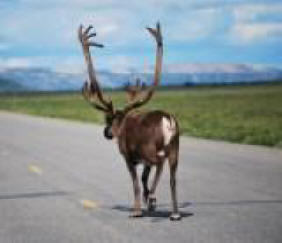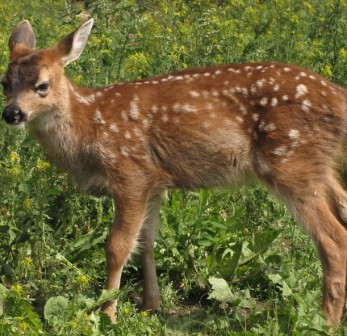Sitka deer call Alaska home. Did you know deer swallow food and then spit it up to chew all over again? This is called ruminating. Deer, like many ungulates, have four-chambered stomachs. This digestive system allows deer to eat a lot of food quickly and then chew and digest it later when they are less exposed to danger from predators. Deer are herbivores, which means they eat plants. They eat a wide variety of plant species but can’t just eat anything. Deer depend on microscopic organisms in their stomachs to break down food. These microbes are specially adapted to a deer’s natural diet. If a deer eats something outside its normal diet, it can become really sick. In fact, deer have died of starvation on a full stomach!
Skunk cabbage is one of the best high-energy foods for deer in spring. Because skunk cabbage is armed with sharp microscopic crystals, it’s painful and dangerous for people to eat. But deer can digest it, and it provides a great source of protein. Deer also eat blueberry and huckleberry, but these are not as nutritious as bunchberry and five-leaf bramble. These forbs are evergreens that provide food for deer in the winter when other foods are not available. However, forbs grow low to the ground and are easily covered by snow. That’s why old-growth forests are so important to deer in Alaska.
The Sitka black-tailed deer is smaller, stockier, and has a shorter face than other members of the black-tailed group. Fawns are born in early June and weigh 6-8 pounds at birth. The average October weight of adults is about 80 pounds for females (does) and 120 pounds for males (bucks), although bucks of over 200 pounds have been reported. The summer coat of reddish-brown is replaced by dark brownish gray in winter. A Sitka black-tail buck’s antlers are dark brown with typical black-tailed branching. Normal adult antler development is three points on each side. Antlers are relatively small, with very few scoring more than 110 points by the Boone and Crockett system. The average life-span of a Sitka black-tail is about 10 years, but some live as long as 15 years.
Fawns, or baby deer, are born in late spring. A doe giving birth the first time will usually have one fawn, and twins from then on. When first born, fawns do not give off any smell, making it difficult for predators such as bears and wolves to find them. The spots on a fawn’s coat provide additional protection. This camouflage resembles filtered sunlight and shadows on the forest floor. Sitka black-tail fawns are born in late spring, following the breeding season in late November. Breeding bucks spend little time foraging and by late November have used up much of their fat reserve, while does generally enter December in prime condition. Does breed during their second year of life and continue producing fawns annually until they reach 10 or 12 years of age. Prime-age does (5-10 years) typically produce two fawns annually.
As the winter snowpack recedes, deer disperse and begin to move about; migratory deer move to high elevation alpine/subalpine habitats while resident deer remain throughout the forest at lower elevations. Summer and early fall are periods of active foraging as deer accumulate fat reserves to help get them through the winter and early spring. With the first signs of winter, usually the first heavy frost, deer in higher alpine and subalpine areas descend to upper elevations of the rain forest.
Deer populations in Alaska are dynamic and fluctuate considerably with the severity of winters. Mild winters generally allow for an increase in the population, but a particularly harsh winter typically spells decline for the population. The deer’s high reproductive potential helps depressed populations to recover rapidly.
The Sitka black-tailed deer is native to the wet coastal rain forests of Southeast Alaska and north-coastal British Columbia. Its range has expanded as a result of transplants, and established populations now exist near Yakutat, in Prince William Sound, and on Kodiak and Afognak Islands. Summer and winter home range areas vary from 30-1,200 acres and, for radio-collared deer on Admiralty Island, they average about 200 acres. Migratory deer have larger annual home ranges than resident deer. The average distance between summer and winter home ranges is five miles for migratory deer and half a mile for resident deer. Movement of deer between watersheds appears to be minimal during winter. During winter, the distribution of deer at various elevations is influenced by changing snow depth. During extreme snow accumulation, many deer congregate in heavily timbered stands at lower elevations and some may even move on to the beach.
|








